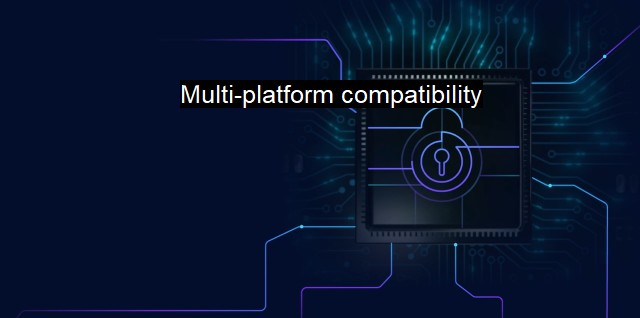What is Multi-platform compatibility?
The Importance of Multi-Platform Compatibility for Cybersecurity in Today's Digital Landscape
Multi-Platform Compatibility is a term popularly associated with the realm of cybersecurity. It essentially denotes the capacity of a software, application or program to run and function, exhibiting all its features seamlessly across various different platforms. For security tools such as antivirus software, the need for multi-platform compatibility cannot be overemphasized, given the extensive spectrum of platforms being employed today.Platforms, in the context of computing, are typically understood as the combination of hardware and operating system that enable software applications to run. Such platforms range widely from traditional computers, whether Windows, MacOS or Linux, to smartphones and tablets running on operating systems like Android and iOS. Not to mention the plethora of IoT devices, including smartwatches, home automation tools, and many similar digital devices that permeate our daily routines.
All these platforms are vulnerable to various cyber threats, from malicious software like viruses and spyware, to sophisticated attacks that exploit security loopholes in the system. To safeguard against such threats, organizations and individuals alike rely on antivirus software. each platform has its own distinct architecture and system requirements and handling security for each one is a unique endeavor.
In the early years of computing, most virus threats were targeted at Windows operations systems, concomitant with its absolute market domination. Consequently, majority of the cybersecurity tools and antivirus software were tailored exclusively for Windows devices. the landscape has significantly evolved since then. The bountiful proliferation of digitally connected devices, especially mobiles and IoT devices and their prevalent use in managing and operating a variety of critical services has led to hackers broadening their horizons and target surfaces. Thus, it's not uncommon today to hear of malware aimed at MacOS, Android, or even obscure platforms like IoT variations.
Being able to combat this plethora of threats over diversified platforms demands a broader spectrum of protection, translating to the need for multi-platform compatible antivirus software. Such software are specially designed and developed to work effectively over multiple platforms. They take into consideration the unique system architecture, specific vulnerabilities, functioning, and other distinct aspects of each platform. From performing an initial system scan, to blocking unauthorized access and harmful downloads, deleting corrupted files and continuously monitoring for any potential harm, all these functions are seamlessly executed over each platform a single software operates on.
Yet developing such universally competent software is a challenge. Though major elements remain the same, the changing dynamics of different platforms must be duly considered. Digital platforms are varied ecosystems demanding different configurations, management practices, updates, and security strategies. The antivirus advancing towards multi-platform compatibility must thoroughly craft their defense system incorporating these factors.
Notwithstanding the challenge, multi-platform compatibility is worth the pursuit. It transforms the efficiency of the cybersecurity strategy as well as the ease of providing rigorous protection. Having a single, highly effective solution, compatible with a wide range of platforms, helps to maintain consistency, and simplifies security management and response.
A further advantage is the ease in monitoring and reporting. With numerous devices and platforms in play, tracking security issues can be overwhelmingly complex. Multi-platform compatibility allows centralized security monitoring and management. Making it easier to track threats, assess security breaches and expedite effective responses.
'Multi-Platform Compatibility' in context of cybersecurity and antivirus signifies far more than a convenient feature. It's a fundamental strategic necessity in the modern digital landscape abound with diverse platforms. The capacity of an antivirus solution to operate effectively across disparate platforms amplifies its protective potency. This capability not only attends to the individual vulnerabilities of each platform but also collectively guards an entire digital infrastructure from the multifaceted menaces that the dubious world of cybercrime ventures to strike.

Multi-platform compatibility FAQs
What does multi-platform compatibility mean in the context of cybersecurity and antivirus software?
Multi-platform compatibility refers to the ability of an antivirus software to operate on multiple operating systems (OS) and devices. It means that the antivirus software can run on different platforms such as Windows, Mac, Linux, iOS, and Android.Why is multi-platform compatibility important for antivirus software?
Multi-platform compatibility is essential for antivirus software as it enables it to protect all devices and operating systems against cyber threats. With the rise of cross-platform malware, it is important to have an antivirus that can protect all devices, regardless of the platform they are running on.Can a multi-platform antivirus provide the same level of protection for all platforms?
The level of protection provided by a multi-platform antivirus can vary depending on the platform. Some platforms may have more vulnerabilities or be more susceptible to certain types of malware, which can affect the effectiveness of the antivirus. However, a good multi-platform antivirus should still provide a high level of protection across all platforms.Do I need to pay extra for a multi-platform antivirus?
Some antivirus software may offer multi-platform compatibility as part of their standard subscription, while others may require an additional fee. It is important to check the pricing and licensing options before purchasing an antivirus software to ensure that it meets your needs and budget.| | A | | | B | | | C | | | D | | | E | | | F | | | G | | | H | | | I | | | J | | | K | | | L | | | M | |
| | N | | | O | | | P | | | Q | | | R | | | S | | | T | | | U | | | V | | | W | | | X | | | Y | | | Z | |
| | 1 | | | 2 | | | 3 | | | 4 | | | 7 | | | 8 | | |||||||